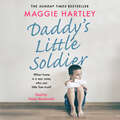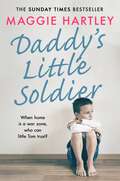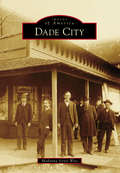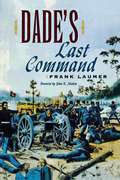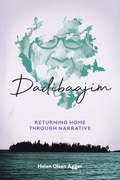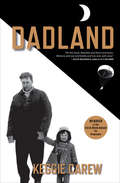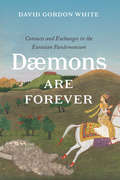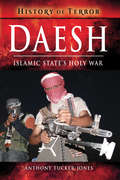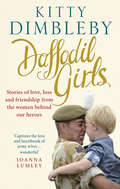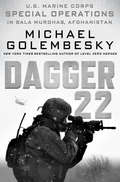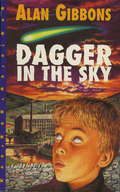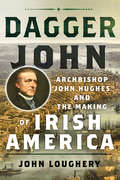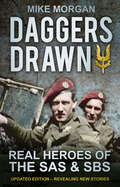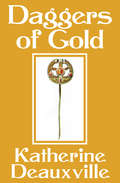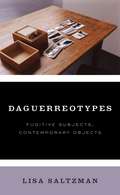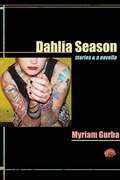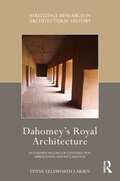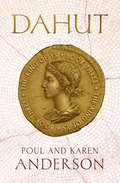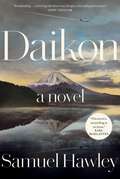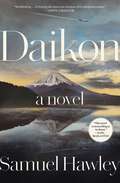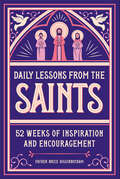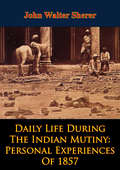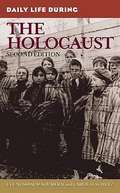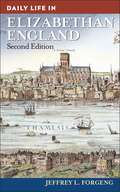- Table View
- List View
Daddy's Little Soldier: When home is a war zone, who can little Tom trust? (A Maggie Hartley Foster Carer Story)
by Maggie HartleyQuiet and polite, obsessively neat, clean and tidy, eight-year-old Tom is unlike any child Maggie has ever fostered before. Tom has been taken into care following concerns that his dad is struggling to cope after the death of Tom's mum. At first, Maggie doesn't know what to make of this shy, nervous little boy who never cries and is terrified of getting dirty. But as Tom's cleaning rituals start to get more extreme, Maggie fears that there's something more sinister going on beneath the surface. When she meets Tom's dad Mark, a stern ex-soldier and strict disciplinarian, it's clear that Tom's life at home without his mummy has been a constant battlefield. Can Maggie help Mark to raise a son and not a soldier? Or is little Tom going to lose his daddy too?
Daddy's Little Soldier: When home is a war zone, who can little Tom trust? (A Maggie Hartley Foster Carer Story)
by Maggie HartleyQuiet and polite, obsessively neat, clean and tidy, eight-year-old Tom is unlike any child Maggie has ever fostered before. Tom has been taken into care following concerns that his dad is struggling to cope after the death of Tom's mum. At first, Maggie doesn't know what to make of this shy, nervous little boy who never cries and is terrified of getting dirty. But as Tom's cleaning rituals start to get more extreme, Maggie fears that there's something more sinister going on beneath the surface. When she meets Tom's dad Mark, a stern ex-soldier and strict disciplinarian, it's clear that Tom's life at home without his mummy has been a constant battlefield. Can Maggie help Mark to raise a son and not a soldier? Or is little Tom going to lose his daddy too?A true story of hope from Sunday Times bestselling author Maggie Hartley, a foster carer for over 20 years.'Such a moving story' 5* Amazon reader review
Dade City
by Madonna Jervis WiseDade City was named for Maj. Francis L. Dade, who perished in the Dade Battle, which opened the Second Seminole War in 1836. As the county seat, formality intermingles with frontier roots in a revered, historic courthouse, a stately jail, and an array of churches and historic homes. Dade City entices visitors with antique shops, cafés, and historical architecture. Folks are drawn to the hospitality of the Kumquat Festival, the homespun county fair, and agricultural showcases at area ranches. In 1908, O. Henry included Dade City in one of his short stories as a symbol of Americana. Surrounding the historic town are alluring places that tell the stories of Florida: the Withlacoochee State Forest, Lake Jovita, Trilby, Lacoochee, and San Antonio to name a few.
Dade's Last Command
by Frank LaumerDade's Battle in December 1835 precipitated the Second Seminole War. It was the first American war fought over the issue of slavery, Frank Laumer writes, and it occurred principally because of white determination to protect the institution.In their search for runaway slaves, white citizens of Georgia and Florida invaded Seminole land and met with resistance; the violent encounters that followed led to Dade's Battle. As a result, Laumer says, the escape hatch was closed, Native Americans were removed from the land, and Florida was made "safe" for white expansion.Coupling thirty years of research with a passion to understand the fate of Major Dade's command and the motivations of the attacking Seminoles, Laumer has written a vivid account of a battle that changed Florida's history. After walking Dade's route on the Fort King Road from Tampa to the battlefield north of the Withlacoochee River--wearing the complete woolen uniform of an enlisted man, carrying musket, canteen, pack, bayonet, and haversack--Laumer can describe not only the clothing and weapons of the soldiers but also the tension and fear they felt as they marched through Seminole territory. He has also assessed the position of the Seminoles, sympathizing with the choices forced by their leaders. Laumer also describes the backgrounds of the soldiers who marched under Dade and the role of much-maligned black interpreter, Louis Pacheco, and he offers new insights on the mistakes made by the commanders who ordered the march.More than the account of a single military action, Dade's Last Command is the story of good and decent men "who died violent and terrible deaths to perpetuate a political and social evil."
Dadibaajim: Returning Home through Narrative (Critical Studies in Native History #22)
by Helen Olsen AggerDadibaajim narratives are of and from the land, born from experience and observation. Invoking this critical Anishinaabe methodology for teaching and learning, Helen Olsen Agger documents and reclaims the history, identity, and inherent entitlement of the Namegosibii Anishinaabeg to the care, use, and occupation of their Trout Lake homelands. When Agger’s mother, Dedibaayaanimanook, was born in 1922, the community had limited contact with Euro-Canadian settlers and still lived throughout their territory according to seasonal migrations along agricultural, hunting, and fishing routes. By the 1940s, colonialism was in full swing: hydro development had resulted in major flooding of traditional territories, settlers had overrun Trout Lake for its resource, tourism, and recreational potential, and the Namegosibii Anishinaabe were forced out of their homelands in Treaty 3 territory, north-western Ontario. Agger mines an archive of treaty paylists, census records, and the work of influential anthropologists like A.I. Hallowell, but the dadibaajim narratives of eight community members spanning three generations form the heart of this book. Dadibaajim provide the framework that fills in the silences and omissions of the colonial record. Embedded in Anishinaabe language and epistemology, they record how the people of Namegosibiing experienced the invasion of interlocking forces of colonialism and globalized neo-liberalism into their lives and upon their homelands. Ultimately, Dadibaajim is a message about how all humans may live well on the earth.
Dadland
by Keggie CarewKeggie Carew grew up in the gravitational field of an unorthodox father who lived on his wits and dazzling charm. For most of her adult life, Keggie was kept at arm's length from her father's personal history, but when she is invited to join him for the sixtieth anniversary of the Jedburghs—an elite special operations unit that was the first collaboration between the American and British Secret Services during World War II—a new door opens in their relationship. As dementia stakes a claim over his memory, Keggie embarks on a quest to unravel her father's story, and soon finds herself in a far more consuming place than she had bargained for.Tom Carew was a maverick, a left-handed stutterer, a law unto himself. As a Jedburgh he was parachuted behind enemy lines to raise guerrilla resistance first against the Germans in France, then against the Japanese in Southeast Asia, where he won the moniker "Lawrence of Burma." But his wartime exploits are only the beginning. Part family memoir, part energetic military history, Dadland takes us on a spellbinding journey, in peace and war, into surprising and shady corners of twentieth-century politics, her rackety English childhood, the poignant breakdown of her family, the corridors of dementia and beyond. As Keggie pieces her father—and herself—back together again, she celebrates the technicolor life of an impossible, irresistible, unstoppable man.
Daemons Are Forever: Contacts and Exchanges in the Eurasian Pandemonium (Silk Roads Ser.)
by David Gordon WhiteA richly illustrated tapestry of interwoven studies spanning some six thousand years of history, Dæmons Are Forever is at once a record of archaic contacts and transactions between humans and protean spirit beings—dæmons—and an account of exchanges, among human populations, of the science of spirit beings: dæmonology. Since the time of the Indo-European migrations, and especially following the opening of the Silk Road, a common dæmonological vernacular has been shared among populations ranging from East and South Asia to Northern Europe. In this virtuoso work of historical sleuthing, David Gordon White recovers the trajectories of both the “inner demons” cohabiting the bodies of their human hosts and the “outer dæmons” that those same humans recognized each time they encountered them in their enchanted haunts: sylvan pools, sites of geothermal eruptions, and dark forest groves. Along the way, he invites his readers to reconsider the potential and promise of the historical method in religious studies, suggesting that a “connected histories” approach to Eurasian dæmonology may serve as a model for restoring history to its proper place at the heart of the discipline of the history of religions.
Daesh: Islamic State’s Holy War (History Of Terror Ser.)
by Anthony Tucker-JonesAnthony Tucker-Jones is only too familiar with the modern architects of terror. For the past decade and a half he has worked as the terrorism and security correspondent for the highly respected intersec The Journal of International Security. During that time he has written extensively on al Qaeda and Daesh. This book draws on his experience to assess Islamic States brutal Holy War that has brought terror and mayhem to the four corners of the globe.The emergence of terror group Islamic State, or Daesh, has created one of the greatest threats to global security in the twenty-first century. Spawned from the conflicts in Iraq and Syria, it carved out an Islamic caliphate straddling both failed countries. Since then it has wantonly despoiled world heritage sites, engaged in regional genocide and conducted regular terror attacks against capital cities across the world, killing irrespective of race, color, creed, gender or age.Like its predecessor, al Qaeda, Daeshs most potent and insidious weapon is franchise terrorism. It has inspired clutches of deadly wannabee terrorists who have carried out a wave of what can be best described as war crimes, killing innocent civilians. In this perceptive assessment Tucker-Jones highlights how the West has become caught up in what is essentially a civil war between Shia and Sunni Islam, with deadly results.
Daffodil Girls: Stories of Love, Loss and Friendship from the Women Behind Our Heroes
by Kitty DimblebyEver wondered what it is like to support a loved one in the armed forces? Army wife and journalist Kitty Dimbleby reveals stories of life, love and loss from the women behind the front line. For every brave soldier putting their life on the line for Queen and country, there is a second, more subtle sort of heroism at work back at base in Britain. Daffodil Girls is the story of the women behind the soldiers of The 2nd Battalion The Royal Welsh. Granted unprecedented access into this most private of communities, writer Kitty Dimbleby brilliantly brings to life the lot of a military wife, as she follows these women through the cycle of a regiment's tour of duty: the preparation for departure, the six long months of action and the emotional reunion. Insightful, humorous and deeply moving in turn, Daffodil Girls captures the unique bond of friendship and indomitable spirit that is forged in such circumstances - the extraordinary world of the heroines behind our army heroes.
Dagger 22: U.S. Marine Corps Special Operations in Bala Murghab, Afghanistan
by Michael GolembeskyThe sequel to New York Times bestseller Level Zero HeroesLevel Zero Heroes, Michael Golembesky's bestselling account of Marine Special Operations Team 8222 in Bala Murghab, Afghanistan, was just the beginning for these now battle-hardened special operations warriors.The unforgiving Afghan winter has settled upon the 22 men of Marine Special Operations Team 8222, callsign Dagger 22, in the remote and hostile river valley of Bala Murghab, Afghanistan. The Taliban fighters in the region would have liked nothing more than to once again go dormant and rest until the new spring fighting season began. No chance of that--this winter would be different.Along with Afghan and International Security Forces (NATO), the Marines of Dagger 22 continued their fight throughout the harsh winter to shape the battlefield before the Afghan ground began to thaw. From one firefight to the next, the noose began to tighten around the village of Daneh Pasab and the Taliban command cell operating there. On April 6, 2010, a ground force consisting of U.S. Army Special Forces, Afghan Commandos and Marine Corps special operations conducted a night assault to destroy the heavily entrenched Taliban force, breaking their grip on the valley and stopping the spring offensive before it even began.But nothing in Bala Murghab comes easily as combat operations wear on the operators of Dagger 22 as they lean on each other once again in order to complete their mission in one of the most brutal environments on earth.
Dagger In The Sky
by Alan GibbonsThe Luddites are rioting. Everywhere there is talk of rebellion. When machinery is brought to the local mill Jem knows where his loyalties lie. And soon he finds himself caught up in a conflict which might destroy him and his family for ever. An exciting story of divided loyalties, by a million-copy-selling author.
Dagger John: Archbishop John Hughes and the Making of Irish America
by John LougheryAcclaimed biographer John Loughery tells the story of John Hughes, son of Ireland, friend of William Seward and James Buchanan, founder of St. John’s College (now Fordham University), builder of Saint Patrick’s Cathedral on Fifth Avenue, pioneer of parochial-school education, and American diplomat. As archbishop of the Archdiocese of New York in the 1840 and 1850s and the most famous Roman Catholic in America, Hughes defended Catholic institutions in a time of nativist bigotry and church burnings and worked tirelessly to help Irish Catholic immigrants find acceptance in their new homeland. His galvanizing and protecting work and pugnacious style earned him the epithet Dagger John. When the interests of his church and ethnic community were at stake, Hughes acted with purpose and clarity.In Dagger John, Loughery reveals Hughes’s life as it unfolded amid turbulent times for the religious and ethnic minority he represented. Hughes the public figure comes to the fore, illuminated by Loughery’s retelling of his interactions with, and responses to, every major figure of his era, including his critics (Walt Whitman, James Gordon Bennett, and Horace Greeley) and his admirers (Henry Clay, Stephen Douglas, and Abraham Lincoln). Loughery peels back the layers of the public life of this complicated man, showing how he reveled in the controversies he provoked and believed he had lived to see many of his goals achieved until his dreams came crashing down during the Draft Riots of 1863 when violence set Manhattan ablaze.To know "Dagger" John Hughes is to understand the United States during a painful period of growth as the nation headed toward civil war. Dagger John’s successes and failures, his public relationships and private trials, and his legacy in the Irish Catholic community and beyond provide context and layers of detail for the larger history of a modern culture unfolding in his wake.
Daggers Drawn: The Real Heroes of the SAS & SBS
by Mike MorganMike Morgan presents 25 stories about the larger-than-life exploits of the SAS and SBS in World War II, supported by a selection of rare archive and action shots. Some stories are previously unpublished.
Daggers of Gold
by Katherine DeauxvilleA Saxon beauty and a courageous knight fall prey to forbidden passion, as the medieval saga that began in Blood Red Roses continues. Romantic Times praises DAGGERS OF GOLD as &“A magnificent love story...real history brought to life by a consummate storyteller.&” Find out for yourself what makes this spellbinding sequel to the best-selling Blood Red Roses so hot! Ingrith is the grand-daughter of a formerly powerful Saxon noble who has fallen from the King&’s grace and left his family in the position of slaves and serfs. Her fiery will and glossy silver tresses set her apart from other peasant girls, but she has no control over her destiny. She remains bound by the will of others due to her family&’s ancient ties to the web of intrigue surrounding the royal family. Her beauty at full flower, she finds herself the unwilling captive of a swarthy knight setting out to prove his loyalty to the King. Ingrith is to be a gift to the King, his servant and whore, until he tires of her. She refuses to submit to such an outrageous violation. But the only way she can escape is with the help of her captor, who has his own debt of honor to pay, and whose gorgeous eyes send shivers down her spine.
Daguerreotypes: Fugitive Subjects, Contemporary Objects
by Lisa SaltzmanIn the digital age, photography confronts its future under the competing signs of ubiquity and obsolescence. While technology has allowed amateurs and experts alike to create high-quality photographs in the blink of an eye, new electronic formats have severed the original photochemical link between image and subject. At the same time, recent cinematic photography has stretched the concept of photography and raised questions about its truth value as a documentary medium. Despite this situation, photography remains a stubbornly substantive form of evidence: referenced by artists, filmmakers, and writers as a powerful emblem of truth, photography has found its home in other media at precisely the moment of its own material demise. By examining this idea of photography as articulated in literature, film, and the graphic novel, Daguerreotypes demonstrates how photography secures identity for figures with an otherwise unstable sense of self. Lisa Saltzman argues that in many modern works, the photograph asserts itself as a guarantor of identity, whether genuine or fabricated. From Roland Barthes’s Camera Lucida to Ridley Scott’s Blade Runner, W. G. Sebald’s Austerlitz to Alison Bechdel’s Fun Home—we find traces of photography’s “fugitive subjects” throughout contemporary culture. Ultimately, Daguerreotypes reveals how the photograph, at once personal memento and material witness, has inspired a range of modern artistic and critical practices.
Dahlia Season
by Myriam Gurba<P>Chicana. Goth. Dykling. Desiree Garcia knows she's weird and a weirdo magnet. To extinguish her strangeness, her parents ship her to Saint Michael's Catholic High School, then to Mexico, but neurology can't be snuffed out so easily: Screwy brain chemistry holds the key to Desiree's madness. <P> As fellow crazies sense a kinship with her, Desiree attracts a coterie of both wanted and unwanted admirers, including a pair of racist deathrock sisters, a pretty Hispanic girl who did time in California's most infamous mental asylum, and a transnational stalker with a pronounced limp. <P>As high school graduation nears, Desiree's weirdness turns from charming to alarming. Plagued by increasingly bizarre thoughts and urges, Desiree convinces herself she's schizophrenic, despite assurance otherwise. In college, she finds Rae, an ex-carnie trannyboi, who becomes the June Carter to her Johnny Cash. With Rae's help, Desiree answers the riddle of her insanity and names her disease. <P>Combining the spark of Michelle Tea, the comic angst of Augusten Burroughs, and the warmth of Sandra Cisneros, Mexican American author Myriam Gurba has created a territory all her own. Dahlia Season not only contains the title novella, but also several of Gurba's acclaimed stories. Myriam Gurba is a high school teacher who lives in Long Beach, California, home of Snoop Dogg and the Queen Mary.
Dahomey’s Royal Architecture: An Earthen Record of Construction, Subjugation, and Reclamation (Routledge Research in Architectural History)
by Lynne Ellsworth LarsenDahomey’s Royal Architecture examines the West African kingdom of Dahomey, located in present-day Republic of Benin. The book explores the Royal Palace of Dahomey’s relationship to the religious, cultural, and national identity of the pre-colonial Kingdom of Dahomey (c. 1625–1892), colonial Dahomey (1892–1960) and post-colonial Benin (1960–present). The Royal Palace of Dahomey covers more than 108 acres and was surrounded by a wall over two miles long. When the French colonial army arrived in Abomey in 1892, the ruling king set fire to the palace to keep it from falling into enemy hands. Though much of the palace structure was subsequently left to ruin, a portion of it was restored from which the French ruled for a short period. In 1945, the colonial administration transformed part of the palace into a museum, and in 1985 the entire palace was added to UNESCO’s World Heritage list. This book documents the palace’s physical transformations in relation to its changing purposes and explores how the space maintained religious significance despite change. The palace’s construction, destruction, and restorations demonstrate how architecture can be manipulated and transformed according to the agendas of governments or according to the religious and cultural needs of a populace. The palace functions as a historic record by discussing aspects of documentation, revision, language, and interpretation. Covering almost four centuries of Dahomey’s history, this book will be of interest to researchers and students of African art and architecture, religious studies, west African history, and post-colonial studies.
Dahut (The King of Ys #3)
by Poul Anderson Karen AndersonIn book three of the King of Ys series, Gratillonius&’s reign faces a deadly new threat from across the sea For sixteen years Gratillonius has been the king of Ys, a position he has used to bring the once-teetering city-state back to stability as the Roman Empire continues to collapse around it. Rome would prefer a more malleable leader in Gratillonius&’s place and makes no secret of it. As pressure from Roman leadership increases, Gratillonius must also contend with Niall maqq Echach, the leader of Northern Ireland who holds the Ysan king responsible for the death of his son. Compounding these complications is the ever-present threat of retribution by the Ysan gods, should the kingdom&’s leadership make a misstep. But perhaps the greatest danger of all is unfolding from within Gratillonius&’s own household, where, following the death of one of his nine wives, the gods have named an unsettling replacement: Dahut, Gratillonius&’s own daughter. As treachery mounts from within and without, Gratillonius must hold to his principles in defiance of the gods while still protecting Ys from the destruction closing in on all sides. Dahut is the third book in Poul and Karen Anderson&’s King of Ys series, which concludes with The Dog and the Wolf.
Daikon: A Novel
by Samuel Hawley&“Thrilling…Builds to a pulse-pounding climax. The result is the most imaginative take on Hiroshima since Edwin Corley&’s The Jesus Factor.&” —Publishers Weekly (starred review) &“A riveting tale about war, intrigue, love, and perseverance.&” —John Grisham • &“I could not look away. This novel is storytelling at its finest.&” —Karl Marlantes • &“Spellbinding…A breathtaking chain reaction that unleashes the true power of the novel.&” —Adam Johnson • &“Extraordinary…Daikon will sweep you away.&” —Jess Walter • &“Exhilarating…I loved this book, and you will love it too.&” —Arthur Golden A sweeping and suspenseful novel of love and war, set in Japan during the final days of World War II, with a shocking historical premise: three atomic bombs were actually delivered to the Pacific—not two—and when one of them falls into the hands of the Japanese, the fate of a couple that has been separated from one another becomes entangled with the fate of this terrifying new device.War has taken everything from physicist Keizo Kan. His young daughter was killed in the Great Tokyo Air Raid, and now his Japanese American wife, Noriko, has been imprisoned by the brutal Thought Police. An American bomber, downed over Japan on the first day of August 1945, offers the scientist a surprising chance at salvation. The Imperial Army dispatches him to examine an unusual device recovered from the plane&’s wreckage—a bomb containing uranium—and tells him that if he can unlock its mysteries, his wife will be released. Working in secrecy under crushing pressure, Kan begins to disassemble the bomb and study its components. One of his assistants falls ill after mishandling the uranium, but his alarming deterioration, and Kan&’s own symptoms, are ignored by the commanding officer demanding results. Desperate to stave off Japan&’s surrender to the Allies, the army will stop at nothing to harness the weapon&’s unimaginable power. They order Kan to prepare the bomb for manual detonation over a target—a suicide mission that will strike a devastating blow against the Americans. Kan is soon confronted with a series of agonizing decisions that will test his courage, his loyalty, and his very humanity. An extraordinary debut novel that is the result of twenty-seven years of work by its author, Daikon is a gripping and powerfully moving saga that calls to mind such classics as Cold Mountain and From Here to Eternity. It is set amid the chaos and despair of the world&’s third largest city lying in ruins, its population starving and its leadership under escalating assault from without and within. Here is a haunting epic of love, survival, and impossible choices that introduces a singular new voice on the literary landscape.
Daikon: A Novel
by Samuel Hawley&“Thrilling…Builds to a pulse-pounding climax. The result is the most imaginative take on Hiroshima since Edwin Corley&’s The Jesus Factor.&” —Publishers Weekly (starred review) &“A riveting tale about war, intrigue, love, and perseverance.&” —John Grisham • &“I could not look away. This novel is storytelling at its finest.&” —Karl Marlantes • &“Spellbinding…A breathtaking chain reaction that unleashes the true power of the novel.&” —Adam Johnson • &“Extraordinary…Daikon will sweep you away.&” —Jess Walter • &“Exhilarating…I loved this book, and you will love it too.&” —Arthur Golden A sweeping and suspenseful novel of love and war, set in Japan during the final days of World War II, with a shocking historical premise: three atomic bombs were actually delivered to the Pacific—not two—and when one of them falls into the hands of the Japanese, the fate of a couple that has been separated from one another becomes entangled with the fate of this terrifying new device.War has taken everything from physicist Keizo Kan. His young daughter was killed in the Great Tokyo Air Raid, and now his Japanese American wife, Noriko, has been imprisoned by the brutal Thought Police. An American bomber, downed over Japan on the first day of August 1945, offers the scientist a surprising chance at salvation. The Imperial Army dispatches him to examine an unusual device recovered from the plane&’s wreckage—a bomb containing uranium—and tells him that if he can unlock its mysteries, his wife will be released. Working in secrecy under crushing pressure, Kan begins to disassemble the bomb and study its components. One of his assistants falls ill after mishandling the uranium, but his alarming deterioration, and Kan&’s own symptoms, are ignored by the commanding officer demanding results. Desperate to stave off Japan&’s surrender to the Allies, the army will stop at nothing to harness the weapon&’s unimaginable power. They order Kan to prepare the bomb for manual detonation over a target—a suicide mission that will strike a devastating blow against the Americans. Kan is soon confronted with a series of agonizing decisions that will test his courage, his loyalty, and his very humanity. An extraordinary debut novel that is the result of twenty-seven years of work by its author, Daikon is a gripping and powerfully moving saga that calls to mind such classics as Cold Mountain. It is set amid the chaos and despair of the world&’s third largest city lying in ruins, its population starving and its leadership under escalating assault from without and within. Here is a haunting epic of love, survival, and impossible choices that introduces a singular new voice on the literary landscape.
Daily Lessons from the Saints: 52 Weeks of Inspiration and Encouragement
by Father Brice HigginbothamLessons from the lives of the saints—a year of daily wisdom and inspirationThe saints inspire us, instruct us, and intercede with God for us. Incorporate their wisdom into your life with Daily Lessons from the Saints. Every week, you'll get to know a different saint—and every day, you'll explore new ways to emulate their faithfulness. The short readings take just 5 minutes or less, so you can easily find time to reflect.Discover what it means to live a life of heroic faith, and focus your intentions through brief practices and prayers. Follow the book alongside the liturgical calendar, or read at your own pace; whatever your approach, the saints will accompany you step by step on your journey closer to God.Daily Lessons from the Saints includes:52 Weeks, 365 days—Connect more deeply by focusing on a single saint (or a pair of saints) every week, with seven daily readings about their lives and legacy.Thoughtful lessons—Discover lessons, exercises, and practices guided by the week's saint, showing you how to apply their timeless wisdom to your modern life.55+ Canonized saints—Delve into the stories of St. Patrick, St. Juan Diego Cuauhtlatoatzin, St. Teresa of Ávila, St. Peter & St. Paul, St. Josephine Bakhita, and many more.Bring the wisdom of the saints into your day with Daily Lessons from the Saints.
Daily Life During The Indian Mutiny: Personal Experiences Of 1857 [Illustrated Edition]
by John Walter Sherer[Illustrated with over one hundred maps, photos and portraits, of the battles, individuals and places involved in the Indian Mutiny]Even a long experience of Indian and the customs of the Indians could have prepared John Sherer for the tumultuous events of the Indian Mutiny of 1857. A tax collector and magistrate, who first arrived in India in 1846, Sherer was posted to the North-West provinces when the Sepoy Revolt started. His experiences as narrated here form an interesting counter point to the military narratives that were written on the engagements of the mutiny. He and his fellow non-combatants and administrators were thrown to the wind as all the official British authorities attempted to put down the revolt. Widely lauded when the book was first published in 1910, it is a must for anyone interested in the Indian Mutiny."Mr Sherer gives a graphic account of the events he witnessed in the terrible times of the Mutiny. He has done right to publish the letters sent to him by Sir James Outram and others; they speak for themselves."--Glasgow Herald."It throws an interesting sidelight on those troublous times from a civilian non-combatant's point of view."--Pall Mall Gazette."Full of exciting adventure, with the added charm of actual personal experience. Written in a vigorous and picturesque style."--Bookseller."Mr Sherer's narrative is full of good stories, and he has done well to republish it in its present form."--Publishers' Circular."This publication will be interesting, instructive, and useful to the younger generation, as throwing a few sidelights on a momentous episode in our national history, and enabling them to estimate in some degree the anxiety, sorrow and horror which moved the nation in thrills and pulsations."--Shooting Times.
Daily Life During the Holocaust (Second Edition)
by Eve Nussbaum Soumerai Carol D. SchulzThe Holocaust--one of the most horrific examples of man's inhumanity to man in recorded history--resulted in the genocide of millions of people, most of them Jews.
Daily Life In Elizabethan England
by Jeffrey L. Singman Jeffrey L. ForgengDaily Life in Elizabethan England: Second Edition offers a fresh look at Elizabethan life from the perspective of the people who actually lived it.
Daily Life and Demographics in Ancient Japan (Michigan Monograph Series in Japanese Studies #63)
by William W FarrisFor centuries, scholars have wondered what daily life was like for the common people of Japan, especially for long bygone eras such as the ancient age (700–1150). Using the discipline of historical demography, William Wayne Farris shows that for most of this era, Japan’s overall population hardly grew at all, hovering around six million for almost five hundred years. The reasons for the stable population were complex. Most importantly, Japan was caught up in an East Asian pandemic that killed both aristocrat and commoner in countless numbers every generation. These epidemics of smallpox, measles, mumps, and dysentery decimated the adult population, resulting in wide-ranging social and economic turmoil. Famine recurred about once every three years, leaving large proportions of the populace malnourished or dead. Ecological degradation of central Japan led to an increased incidence of drought and soil erosion. And war led soldiers to murder innocent bystanders in droves. Under these harsh conditions, agriculture suffered from high rates of field abandonment and poor technological development. Both farming and industry shifted increasingly to labor-saving technologies. With workers at a premium, wages rose. Traders shifted from the use of money to barter. Cities disappeared. The family was an amorphous entity, with women holding high status in a labor-short economy. Broken families and an appallingly high rate of infant mortality were also part of kinship patterns. The average family lived in a cold, drafty dwelling susceptible to fire, wore clothing made of scratchy hemp, consumed meals just barely adequate in the best of times, and suffered from a lack of sanitary conditions that increased the likelihood of disease outbreak. While life was harsh for almost all people from 700 to 1150, these experiences represented investments in human capital that would bear fruit during the medieval epoch (1150–1600).
